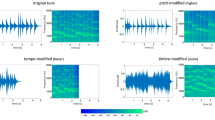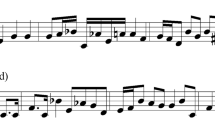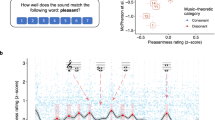Summary
The psychological relevance of the musicians' concept of tonality was tested in the context of the music of J. S. Bach. Musically trained listeners were instructed to sing the musical scale that first came to mind immediately after hearing short excerpts from Preludes of J. S. Bach'sThe Well-Tempered Clavier. For each Prelude, the tonic (first note) and the mode (major or minor) of the scale produced were compared to the tonic and mode designated by Bach. Results indicated that listeners (1) often established the designated tonic and mode within the first four notes of the piece; (2) within the first four bars, often established tonalities different from that of the designated key, a tendency that increased by the eighth bar; and (3) reestablished the tonic in the last four bars. These observations validate, in general, music-theoretic assumptions about the listener's hearing of tonality, and raise issues regarding the salient relations that engage the cognitive structures underlying tonality perception.
Similar content being viewed by others
References
Apel, W. (Ed.), (1969).The Harvard dictionary of music (2nd ed.). Cambridge: Belknap Press.
Brown, H. (1988). The interplay of set content and temporal context in a functional theory of tonality perception.Music Perception, 5, 219–250.
Butler, D., & Brown, H. (1984). Tonal structure versus function: Studies of the recognition of harmonic motion.Music Perception, 2, 6–24.
Cohen, A. J. (1977). Perception of tone sequences from the Western European chromatic scale: Tonality, transposition and the pitch set. Unpublished doctoral dissertation. Queen's University, 1975.Doctoral Dissertation Abstracts International, 37, 4179B, (National Library in Ottawa Order No. PC26238).
Cohen, A. J. (1978). Inferred sets of pitches. Paper presented at the Symposium on the Cognitive Structure of Musical Pitch (R. N. Shepard, chair), Western Psychology Association Meeting, San Francisco.
Cohen, A. J. (1982). Exploring the sensitivity to structure in music.Canadian University Music Review, 3, 15–30.
Cohen, A. J., Trehub, S. E., & Thorpe, L. A. (1989). Effects of uncertainty on melodic information processing.Perception & Psychophysics, 46, 18–28.
Cuddy, L. L., & Cohen, A. J. (1976). Recognition of transposed melodic sequences.Quarterly Journal of Experimental Psychology, 28, 255–270.
Cuddy, L. L., Cohen, A. J., & Mewhort, D. J. K. (1981). Perception of structure in short melodic sequences.Journal of Experimental Psychology: Human Perception and Performance, 7, 869–883.
Erickson, R. (1982). New music and psychology. In D. Deutsch (Ed.),The psychology of music (pp. 517–530). New York: Academic.
Forte, A. (1962).Tonal harmony in concept and practice. New York: Holt, Rinehart, Winston.
Frankland, B. W., & Cohen, A. J. (1989). Interference effects of tonality and contour on shortterm memory for tones. In A. J. Cohen (Ed.),Proceedings of the 1989 meeting of the Canadian Acoustical Association (pp. 117–122). Halifax: Canadian Acoustical Association.
Frankland, B. W., & Cohen, A. J. (1990). Expectancy profiles generated by major scales: Group differences in ratings and reaction time.Psychomusicology, 9, 175–183.
Garner, W. (1974).Processing of information and structure. New York: Wiley.
Helmholtz, H. (1954).Sensations of tone as a physiological basisfor the theory of music (4th ed.), (A. J. Ellis, Trans. and Ed., 1885). New York: Dover.
Hopkins, A. (1979).Understanding music. London: Dent.
Iliffe, F. (1965).Analysis of Bach's 48 Preludes and Fugues (Book 1). Kent: Novello.
Keller, H. (1976).The Well-tempered clavier by Johann Sebastian Bach. L. Gerdine (trans). NY: W. W. Norton. [Originally published in German as Das wohltemperierte Klavier, Kassel: Bärenreiter-Ver-rlag, 1965]
Krumhansl, C. L. (1979). The psychological representation of musical pitch in a tonal context.Cognitive Psychology, 11, 346–374.
Krumhansl, C. L. (1983). Perceptual structures for tonal music.Music Perception, 1, 28–62.
Krumhansl, C. L. (1990).The cognitive foundations of musical pitch. New York: Academic.
Krumhansl, C. L., & Kessler (1982). Tracing the dynamic changes in perceived tonal organization in a spatial representation of musical keys.Psychological Review, 89, 334–368.
Krumhansl, C. L., & Shepard, R. N. (1979). Quantification of the hierarchy of tonal functions within a diatonic context.Journal of Experimental Psychology: Human Perception and Performance, 5, 579–594.
Lockhart, R. S., & Craik, F. I. M. (1990). Levels of processing: A retrospective commentary on a framework for memory research.Canadian Journal of Psychology, 44, 87–112.
Parncutt, R. (1989).Harmony: A psychoacoustical approach. Berlin: Springer-Verlag.
Roberts, L. A., & Shaw, M. L. (1984). Perceived structure of triads.Music Perception, 2, 95–124.
Rosen, C. (1972).The classical style. New York: W. W. Norton
Schenker, H. (1954).Harmony (E. M. Borgese, trans.) Chicago: University of Chicago Press.
Schmuckler, M. (1989). Expectation in music: Investigation of melodic and harmonic processes.Music Perception, 7, 109–150.
Schoenberg, A. (1969). Structural functions of harmony (rev. ed. Leonard Stein, Ed.). New York: Norton. [first edition 1954]
Schoenberg, A. (1973). The problems of harmony.Perspectives of New Music, 11, 1–23. [first published 1934, trans. by A. Weiss]
Terry, C. S. (1963).The music of Bach. London: Dover. [first edition by Oxford University Press, 1933]
Thompson, W. F. (1986). Judgements of key change in Bach chorale excerpts: an investigation of the sensitivity to keys, chords, and voicing. PhD thesis. Dept. of Psychology, Queen's University, Kingston, Ontario, Canada.
Thompson, W. F., & Cuddy L. L. (1989). Sensitivity to key change in chorale sequences: A comparison of single voices and four-voice harmony.Music Perception, 7, 151–168.
Umemoto, T. (1990). The psychological structure of music.Music Perception, 8, 115–128.
Watkins, A. J. (1985). Perceptual aspects of synthesized approximations to melody.Journal of the Acoustical Society of America, 78, 1177–1188.
Author information
Authors and Affiliations
Rights and permissions
About this article
Cite this article
Cohen, A.J. Tonality and perception: Musical scales primed by excerpts fromThe Well-Tempered Clavier of J. S. Bach. Psychol. Res 53, 305–314 (1991). https://doi.org/10.1007/BF00920484
Received:
Accepted:
Issue Date:
DOI: https://doi.org/10.1007/BF00920484




